|
|
 |
|
|
US 6th Armored Division
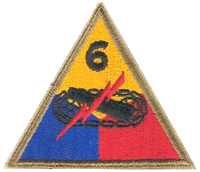 |
US 6th Armored Division in Normandy
and Brittany
By Merle Delinger
While the US 1st Armored Division (Old Ironsides) was slugging it’s way through Italy, five other US armoured divisions were fighting their way onto the beaches at Normandy and then through the bocage country. Two of these divisions have become the most well known over the course of time, that being 2nd Armored Division (Hell On Wheels) and 3rd Armored Division (Spearhead) as featured in Cobra. |
|
However, three other divisions played an integral role as well. Let’s take a brief look at the 6th Armored Division.
6th Armored Division (Super Sixth)
6th Armored Division (Super Sixth) was activated 15 February 1942 also at Fort Knox, Kentucky and was made up almost entirely of citizen draftee soldiers. 6th Armored Division training stations included Camp Chaffee, Ark., Louisiana Manoeuvres, the Mojave Desert, and Camp Cooke, CA. It arrived in England in February 1944 and landed at Utah Beach on 18 July 1944.
|
|
On 18 July 1944, two years and five months after the organization of the 6th Armored Division, leading elements began disembarking on Utah Beach. By 24 July the last of the division’s troops and equipment was assembled in the vicinity of Le Mesnil near the west coast of the Cherbourg Peninsula. Originally the Division was assigned to XX US Corps, Third US Army, which was not yet operational. But when the Allied Air Forces blew a hole in the German defensive lines and a breakthrough created on 25 July, 6th Armored Division was assigned to VIII Corps with instructions to pass through the 79th Division and seize the high ground northwest of Coutances.
Troop A, 86th Cavalry Reconnaissance Squadron, Mechanized, thus became the first 6th Armored Division unit committed. The Troop moved out at 1630 on 27 July and gained the south bank of the Seves River before dark and subsequently led Combat Command A (CCA) to the Sienne River on 28 July. Troop A had the Division's first contact with the enemy late in the evening of 28 July, near Coutances, and captured their first prisoner of war.
The first contact in force came on 29 July when CCA forced a crossing of the Sienne at Pont De La Roque west of Countances. After clearing moderate resistance on the north bank, the division advanced 26 miles on its first day in combat. The following 48 hour period saw the liberation of the French cities of Brehal and Granville. Resistance was stubborn in spots, but usually only by small forces fighting delaying actions. More than 800 green-clad prisoners were captured during the three days.
|
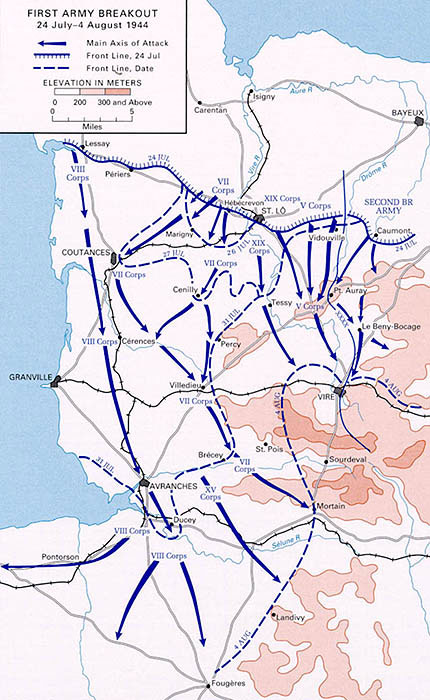 |
|
On 1 August, the Third US Army became operational under the leadership of “Ol’ Blood and Guts”, General George S. Patton Jr. This brought VIII Corps and 6th Armored Division under new leadership. With this change of Armies the division received the general directive to drive up the centre of the Brittany Peninsula and capture Brest. The 4th Armored Division followed initially and then moved on to Rennes and Lorient.
VIII Corps selected two routes through the centre of the Brittany Peninsula toward Brest as general guidelines for 6th Armored Division to follow, with instructions that major centres of resistance were to be avoided in order to reach Brest with all possible speed. On 2 August the advance on the coastal city began in earnest in two columns, with CCB on the right.
|
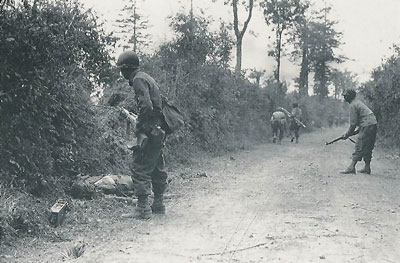 |
All elements of the division marched through the night halting only to refuel. No enemy opposition was encountered, other than a few scattered shots, and there were no obstacles except one blown bridge on each combat command route. By this time the French FFI (French resistance fighters formally organised) was coming out into the open and proved to be of the greatest assistance to the division as guides and informants. They also harassed and hurried the departure of small German garrisons in the interior towns.
|
|
During the all night march, FFI men were out in each town to guide columns. On 5 August another bypass was made when the FFI informed the division that the city of Carhaix was heavily prepared for defence by 2,000 German Fallschirmjäger of the 2. Fallschirmjägerdivision.
As a result of the 6th Armored Division bypassing Carhaix, the city was later evacuated and the tankers’ advance on Brest was not delayed. That afternoon CCA and CCB advanced on Huelgoat. Darkness set in postponing the attack until the following morning, 6 August, when all resistance in the village was overcome.
As the days passed and the distance from supply points increased, the first pinch for gasoline was felt by 6th Armored Division. The division had moved so far from Corps and Army areas that evacuation of prisoners and wounded was extremely difficult. Some wounded were carried forward in ambulances with the advancing columns. Division Trains, supported many times with tanks in their columns, were constantly on the road supplying 6th Armored Division from supply points now far back towards the base of the peninsula.
|
| On 7 August CCB struck the Brest defences from the northwest but met strong direct fire resistance that made it apparent that a stronger force and a coordinated attack would be necessary. Unfortunately CCA did not come up on the left until late in the evening and CCR (Combat Command Reserve) following CCB could not reach a position in the centre in time for a coordinated attack on 7 August or even early on 8 August. The situation indicated that a coordinated attack employing the entire power of the division would be necessary to take Brest. The attack would have to be made quickly or even more force would be required. |
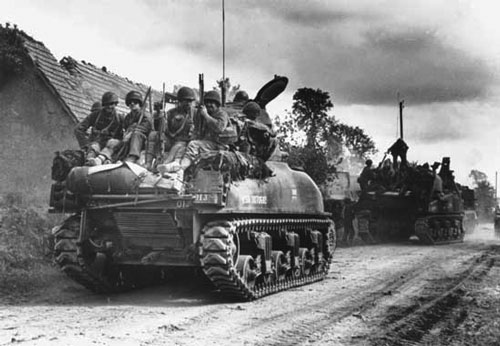 |
|
However, a certain amount of recon, repositioning of forces and supporting artillery positions was necessary on 8 August.
If these three columns could have struck simultaneously during the day of 7 August, before the enemy had a chance to recover from the surprise that the approach from the north had provided, it is very likely that the city could have been entered against light resistance. Unfortunately, the columns could not arrive at the same time, and the enemy was given ample warning to man his defences to the northeast and to sight his anti-aircraft guns for ground fire. These defences continued to be strengthened by reinforcements arriving each day.
On the morning of 8 August, the Division G-2, Lieutenant-Colonel Ernest W. Mitchell Jr., entered the fortress city of Brest in a jeep flying a white flag and was taken to the German commander where he delivered an ultimatum in the name of 6th Armored Division commander. The ultimatum, which gave the fortress the choice of surrendering or of being destroyed, was refused.
|
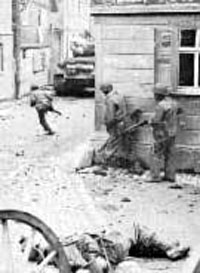 |
The entire plan changed early in the evening of 8 August. A considerable sized German force was moving toward Brest from Morlaix by way of Plouvien from behind 6th Armored Division. German units struck the rear of the division, including the Division Trains, during the early evening hours. A serious threat was building up. By midnight, the German division commander was captured and the unit was determined to be the 266. Infanteriedivision. Major General Grow, 6th Armored Division Commander, immediately cancelled the attack on Brest and directed the combat commands to reverse their directions, leaving a covering force facing Brest. They moved to the north at daylight to attack and destroy the enemy division.
By 10 August, the 266. Infanteriedivision was considered completely destroyed, and the greater part of 6th Armored Division troops were in an assembly area west of Plouvien. It was the first day since 27 July that the troops had an opportunity for a day's rest and maintenance. Plans continued for an attack against Brest, and artillery positions were picked that would allow for the support of an attacking column all the way into the city without displacing the guns.
|
| 6th Armored Division G-2 estimated that the enemy held the outer defences of Brest along the general line of St. Renan-Gouesnou-Guipavas. These defences consisted of previously prepared positions including concrete pillboxes, foxholes, AT guns, and minefields all covered by registered artillery fire. Roadblocks were well emplaced to cover the approaches to the city. Bridges and certain buildings had been prepared for demolition, with the city itself similarly prepared. Guarding the outer defences was an estimated force of 3000, reinforced by at least one regiment of the 2. Fallschirmjägerdivision, plus naval and marine units as well as FlaK units of unknown strength. |
The fight with the 266. Infanteriedivision allowed the garrison at Brest to become fully alerted. The chance for capture by a sudden stroke, which might have been possible on 7 August, was now gone. There were an estimated 20,000 enemy troops in Brest. On 9 August General Grow had called upon VIII Corps for reinforcements of both artillery and infantry to insure a successful attack on Brest. However, three days later, orders were received to halt the attack on Brest, leave one combat command to contain the enemy, and move the remainder of 6th Armored Division at once to the Lorient area to relieve 4th Armored Division. VIII Corps then began the movement of three Infantry divisions to assault the fortress city.
CCA remained in the Brest area while CCB made arrangements to relieve elements of 4th Armored Division in the area north and east of Vannes beginning on 14 August. |
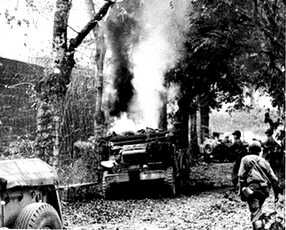 |
|
By 15 August, all elements of the 4th Armored Division were relieved in the Lorient sector of the Peninsula. The front included the defences of Lorient and Quiberon Peninsula to the east, a line of some 25 miles, plus patrols as far west as the base of the Daoulas Peninsula and east to Redon.
The Brittany campaign was finished. 6th Armored Division turned east to take part in the Sielle and Saar River campaigns, the dash north to the Bastogne area, crossing the Siegfried Line, the Rhineland Campaign and finally the liberation of the concentration camps at Buchenwald. 6th Armored Division was deactivated 18 September 1945 at Camp Shanks, New York.
|
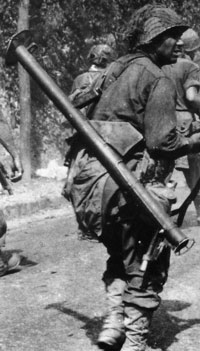 |
6th Armored Division Order of Battle
Headquarters Company (Major General Robert W Grow)
Reserve Command (Chief of Staff: Colonel Glen C McBride)
Combat Command A (Brigadier Fen James Taylor)
Combat Command B (Colonel George W Read Jr.)
15th Tank Battalion
68th Tank Battalion
69th Tank Battalion
9th Armored Infantry Battalion
44th Armored Infantry Battalion
50th Armored Infantry Battalion
86th Cavalry Recon Squadron (Mechanized)
25th Armored Engineer Battalion
146th Armored Signal Company
6th Armored Division Artillery (Lieutenant Colonel William R Jesse)
128th Armored Field Artillery Battalion
212th Armored Field Artillery Battalion
231st Armored Field Artillery Battalion |
|
Attachments During Operation Cobra
Anti-aircraft Artillery
777th Anti-aircraft Artillery Battalion (SP)
Field Artillery
Battery C 965th Field Artillery Battalion (155mm Howitzers)
83rd Armored Field Artillery Battalion
174th Armored Field Artillery Battalion
969th Field Artillery Battalion (155mm Howitzers)
45th Field Artillery Battalion (8th Division) (105mm Howitzers)
28th Field Artillery Battalion (8th Division) (105mm Howitzers)
|
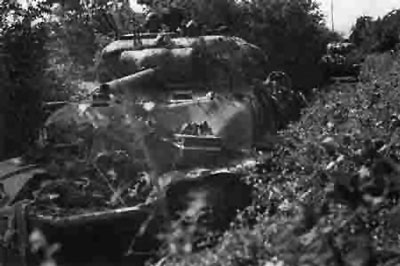 |
|
Infantry
1st Battalion 28th Infantry Regiment (8th Division)
28th Infantry Regiment (8th Division)
Tank Destroyer
603d Tank Destroyer Battalion (SP)
|
Last Updated On Wednesday, October 16, 2019 by Wayne at Battlefront
|
|
|